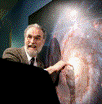Authors
S.J. Collier, University of St. Andrews, St. Andrews, Scotland
Keith Horne, University of St. Andrews, St. Andrews, Scotland
Shai Kaspi, Tel Aviv UniversityFollow
Hagai Netzer, Tel Aviv UniversityFollow
Bradley M. Peterson, Ohio State UniversityFollow
I. Wanders, University of St. Andrews, St. Andrews, Scotland
T. Alexander, School of Physics and Astronomy and the Wise Observatory, The Raymond and Beverly Sackler Faculty of Exact Sciences, Tel Aviv University, Tel Aviv, Israel
R. Bertram, Ohio State University, Columbus, OH
A. Comastri, Osservatorio Astronomico di Bologna, via Zamboni, Bologna, Italy
C. Martin Gaskell, University of Nebraska-LincolnFollow
Yu. F. Malkov, Crimean Astrophysical Observatory, Crimea, Ukraine
D. Maoz, School of Physics and Astronomy and the Wise Observatory, The Raymond and Beverly Sackler Faculty of Exact Sciences, Tel Aviv University, Tel Aviv, Israel
M. Mignoli, Osservatorio Astronomico di Bologna, viz Zamboni, Bologna, Italy
Richard William Pogge, Ohio State UniversityFollow
V.I. Pronik, Crimean Astrophysical Observatory, Crimea, Ukraine
S.G. Sergeev, Crimean Astrophysical Observatory, Crimea, Ukraine
Stephanie A. Snedden, University of Nebraska-LincolnFollow
G.M. Stirpe, Osservatorio Astronomico di Bologna, via Zamboni, Bologna, Italy
N.G. Bochkarev, Sternberg Astronomical Institute, Moscow, Russia
A.N. Burenkov, Special Astrophysical Observatory of Russian Academy of Sciences, Nyzhnij Arkhyz, Russia
A.I. Shapovalova, Special Astrophysical Observatory of Russian Academy of Sciences Nyzhnij Arkhyz, Russia
R.M. Wagner, Ohio State University, Columbus
Date of this Version
6-10-1998
Abstract
We present results of an intensive 2 month campaign of ground-based spectrophotometric monitoring of the Seyfert 1 galaxy NGC 7469, with a temporal resolution [approximately less than]1 day. The broad Hα and Hβ emission lines respond to ~35% ultraviolet continuum variations with an amplitude of ~10% and time delays of 5.6±1.3 days and 5.4±0.8 days, respectively. We interpret this as evidence of variable Balmer line gas ~5-6 light days from the central source in this object, widely believed to be a supermassive black hole. The virial mass of the central source implied by line widths and time delays is ~106-107 M◉ Concomitantly, we find evidence for wavelength-dependent continuum time delays : optical continuum variations lag those at 1315 Å by 1.0±0.3 days at 4865 Å to 1.5±0.7 days at 6962 Å. . This suggests a stratified continuum reprocessing region extending several light days from the central source, possibly an accretion disk.



Comments
Published in THE ASTROPHYSICAL JOURNAL, 500:162-172, 1998 June 10, 1998. Copyright The American Astronomical Society; published by University of Chicago Press. Used by permission. http://www.journals.uchicago.edu/ApJ/issues.html.